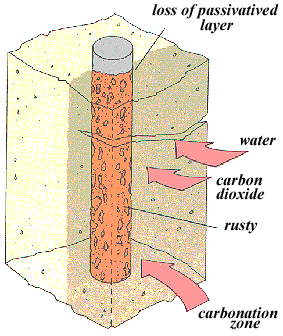![]()
Cracks Must be Repaired
A crack in concrete caused by movement in
a structure can be a real problem. Walls and columns may be weakened by cracking. When
strength is not a major issue, water enters through the crack can be even more troublesome
than the crack itself. If a crack is not properly repaired, it will lead to extensive
cracking and concrete spalling because steel reinforcement bars will be damaged by ingress
of many corrosive minerals.
Epoxy Injection The ideal injection is thin enough to
penetrate small cracks and set quickly before any leaking water may push it out of the
crack or away from the crack wall. To obtain a result of achieving structural strength,
epoxy is a good material for the injection but it is only applied on dry or wet surface. Injection Method Injection is usually accompanied by
machinery to obtain enough pressure to inject epoxy to the hairline cracks. Technique and
patience are important for injection works. It is recommended that epoxy is injected along
the crack at a certain interval of not less than the depth of the crack to ensure the
crack is fully filled with. The injection process follows these simple steps: clean debris from the crack surface and
try not to enlarge the crack surface. flush the crack with water or
compressed air if necessary to remove dust for easy penetration. injecting suitable epoxy. Principle of Epoxy Injection Epoxy injection is an effective method to
seal up the crack completely and maintain the integrity of the structural, ensuring the
best repairs to the crack in the concrete. It prevents the crack from further extending
and stops water from leaking through the concrete. On the other hand, epoxy injection
should be equipped with high pressure and low speed injection machine to achieve the best
effects for filling up hairline concrete cracks. The theory is to inject epoxy at one
point on the crack surface as beginning, the epoxy will gradually spread outward to
another point for leaking (referring to below diagram that injection is carried out at
point B and leaks at point C). With this procedure, epoxy injection is undertaken at one
point by one point. For
sealing water leaks through cracks, epoxy injection gives the best results. Surface
coatings will not usually seal cracks for long, neither the V-cut method. The side of the
structure where water originates is called "positive" side and will normally inaccessible. However, waterproofing
materials applied on "negative" side surface often fail because they depend on their bond strength
to the surface.
For
sealing water leaks through cracks, epoxy injection gives the best results. Surface
coatings will not usually seal cracks for long, neither the V-cut method. The side of the
structure where water originates is called "positive" side and will normally inaccessible. However, waterproofing
materials applied on "negative" side surface often fail because they depend on their bond strength
to the surface.
Procedure :
Stick a plastic tape at an interval of 200mm (similar to the thickness of the concrete slab) along the crack as an inlet for injection or fix plastic tubes depending on the roughness of the concrete surface.
Seal up the crack on concrete surface with epoxy E209 gel.
After the E209 is dried up and hardened, the plastic tape can be torn out of the crack. (an inlet is left for injection on the crack as indicated at Point B in diagram.)
With injection machine to inject epoxy E206 at the first point on the crack surface until the epoxy leaks at the second point. Using wax or soap to rub at the first point to stop the epoxy from running out temporarily.
Repeat the above procedure to inject epoxy on the second point until epoxy leaks at third point and so on to the end of the crack.
Finally, seal up the points of inlet for injection with the E209 on the crack.